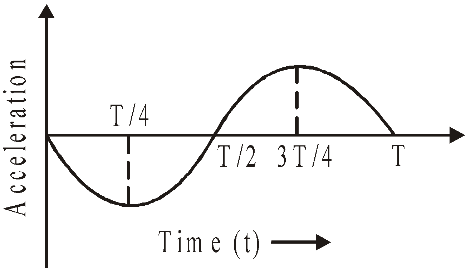
Acceleration of a particle, executing SHM, at its mean position is
(A) Infinity
(B) Varies
(C) Maximum
(D) Zero
Answer
216.6k+ views
Hint: The restoring force works in the opposite direction of the displacement and is inversely proportional to the particle's displacement from its mean position. The mass times the acceleration product also equals this force. The particle's displacement is zero at mean position.
Complete answer:
Simple harmonic motion is when a particle oscillates up and down (back and forth) about a mean position (also known as equilibrium position) in such a way that a restoring force/ torque acts on the particle, which is proportional to displacement from mean position but acts in the opposite direction from displacement. It is known as a linear S.H.M. if the displacement is linear, and an angular S.H.M. if the displacement is angular.
Example:
1) a body suspended by a spring moving
2) Simple pendulum oscillations
Acceleration of a particles:
In S.H.M., a particle's acceleration is given by $a=\dfrac{dv}{dt}=-{{\omega }^{2}}A\sin (\omega t+\phi )$or $a=-{{\omega }^{2}}y$.
The acceleration is pointed toward the mean position, as shown by the negative sign
${{a}_{\max }}=-{{\omega }^{2}}A$ when$y=A$ (at an extreme position).

When undergoing SHM, a particle will accelerate as it approaches the mean position before decelerating till it reaches its end locations. As a result, the net acceleration is constant at zero.
So, the correct option is D.
Note: SHM has a total energy of $1/2M{{\omega }^{2}}{{A}^{2}}$. Equation $a=-{{\omega }^{2}}y$ demonstrates that if a body performs a S.H.M., its acceleration will be proportional to its displacement but will be in the opposite direction. Any motion must meet this crucial criteria in order to be valid.
Complete answer:
Simple harmonic motion is when a particle oscillates up and down (back and forth) about a mean position (also known as equilibrium position) in such a way that a restoring force/ torque acts on the particle, which is proportional to displacement from mean position but acts in the opposite direction from displacement. It is known as a linear S.H.M. if the displacement is linear, and an angular S.H.M. if the displacement is angular.
Example:
1) a body suspended by a spring moving
2) Simple pendulum oscillations
Acceleration of a particles:
In S.H.M., a particle's acceleration is given by $a=\dfrac{dv}{dt}=-{{\omega }^{2}}A\sin (\omega t+\phi )$or $a=-{{\omega }^{2}}y$.
The acceleration is pointed toward the mean position, as shown by the negative sign
${{a}_{\max }}=-{{\omega }^{2}}A$ when$y=A$ (at an extreme position).

When undergoing SHM, a particle will accelerate as it approaches the mean position before decelerating till it reaches its end locations. As a result, the net acceleration is constant at zero.
So, the correct option is D.
Note: SHM has a total energy of $1/2M{{\omega }^{2}}{{A}^{2}}$. Equation $a=-{{\omega }^{2}}y$ demonstrates that if a body performs a S.H.M., its acceleration will be proportional to its displacement but will be in the opposite direction. Any motion must meet this crucial criteria in order to be valid.
Recently Updated Pages
JEE Atomic Structure and Chemical Bonding important Concepts and Tips

JEE Amino Acids and Peptides Important Concepts and Tips for Exam Preparation

Electricity and Magnetism Explained: Key Concepts & Applications

Chemical Properties of Hydrogen - Important Concepts for JEE Exam Preparation

JEE Energetics Important Concepts and Tips for Exam Preparation

JEE Isolation, Preparation and Properties of Non-metals Important Concepts and Tips for Exam Preparation

Trending doubts
JEE Main 2026: Application Form Open, Exam Dates, Syllabus, Eligibility & Question Papers

Derivation of Equation of Trajectory Explained for Students

Hybridisation in Chemistry – Concept, Types & Applications

Understanding the Angle of Deviation in a Prism

Understanding Collisions: Types and Examples for Students

How to Convert a Galvanometer into an Ammeter or Voltmeter

Other Pages
JEE Advanced Marks vs Ranks 2025: Understanding Category-wise Qualifying Marks and Previous Year Cut-offs

Units And Measurements Class 11 Physics Chapter 1 CBSE Notes - 2025-26

NCERT Solutions For Class 11 Physics Chapter 8 Mechanical Properties Of Solids

Motion in a Straight Line Class 11 Physics Chapter 2 CBSE Notes - 2025-26

NCERT Solutions for Class 11 Physics Chapter 7 Gravitation 2025-26

Understanding Atomic Structure for Beginners




